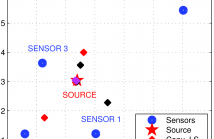- Multi-channel Signal Processing
- Sensor and Relay Networks
- Multi-antenna and Multi-channel Signal Processing for Communications
- Applications of Sensor Array and Multi-channel Signal Processing
- Adaptive Array Signal Processing
- Sensor Array Processing

- Read more about Detector Design for Distributed Multichannel Radar Sensors in Colored Interference Environments
- Log in to post comments
In this paper, we present a generic signal model applicable to various distributed radar setups, encompassing both phased array (PA) and MIMO radar configurations. We consider a range of waveform modulation methods, including TDM, BPM, DDM, and fast time CDM. We devise a GLRT based detector for scenarios where the interference consists of colored noise plus a signal in a low-rank subspace and prove that the designed detector is CFAR.
- Categories:
 32 Views
32 Views
- Read more about Application Informed Motion Signal Processing for Finger Motion Tracking Using Wearable Sensors
- Log in to post comments
- Categories:
 61 Views
61 Views
- Read more about Robust TDOA Indoor Tracking Using Constrained Measurement Filtering and Grid-Based Filtering
- Log in to post comments
- Categories:
 59 Views
59 Views
- Read more about CNN-BASED INDOOR OCCUPANT LOCALIZATION VIA ACTIVE SCENE ILLUMINATION
- Log in to post comments
- Categories:
 24 Views
24 Views
- Read more about A Data-Selective LS Solution to TDOA-based Source Localization
- Log in to post comments
In this paper, the localization of an emitter based on Time Difference of Arrival (TDoA) has been investigated. The classical least-squares (LS) algorithm, with a limited number of TDoA measurements, has been utilized for obtaining a closed-form solution to the source localization problem. Recently, an extension of the classical LS algorithm has been employed in an attempt to improve the precision of the localization technique by using a larger set of TDoA estimates.
PosterTDOA.pdf
- Categories:
 51 Views
51 Views
- Read more about ANALYSIS OF COPRIME ARRAYS ON MOVING PLATFORM
- Log in to post comments
Moving platforms enable sparse arrays to assume higher degrees of freedom and lead to increased number of lags. In essence, array motion can fill the holes in the spatial autocorrelation lags associated with a fixed platform and, therefore, increase the number of sources detectable by the same number of physical array sensors. In this paper, we consider coprime arrays, and assume quasi-stationarity of the environment, where the source locations and waveforms are considered invariant over array motion of half wavelength.
- Categories:
 46 Views
46 Views
In the 3.5 GHz Citizens Broadband Radio Service (CBRS), 100 MHz of spectrum will be shared between commercial users and federal incumbents. Dynamic use of the band relies on a network of sensors dedicated to detecting the presence of federal incumbent signals and triggering protection mechanisms when necessary. This paper uses field-measured waveforms of incumbent signals in and adjacent to the band to evaluate the performance of matched-filter detectors for these sensors.
- Categories:
 35 Views
35 Views
- Read more about Subspace-Based Localization of Near-Field Signals in Unknown Nonuniform Noise
- Log in to post comments
SAM2018最新版.pdf
- Categories:
 21 Views
21 Views
- Read more about Short Data Record Filtering for Adaptive Underwater Acoustic Communications
- Log in to post comments
- Categories:
 40 Views
40 Views
- Read more about Antenna Array Based Positional Modulation with a Two-Ray Multi-Path Model
- Log in to post comments
Traditional directional modulation (DM) designs are based on the assumption that there is no multi-path effect between
- Categories:
 30 Views
30 Views